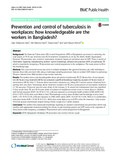| dc.contributor.author | Islam, Qazi Shafayetul | |
| dc.contributor.author | Islam, Md Akramul | |
| dc.contributor.author | Islam, Shayla | |
| dc.contributor.author | Ahmed, Syed Masud | |
| dc.date.accessioned | 2016-05-08T10:11:22Z | |
| dc.date.available | 2016-05-08T10:11:22Z | |
| dc.date.copyright | 2015 | |
| dc.date.issued | 2015-06 | |
| dc.identifier.citation | Islam, Q. S., Islam, M. A., Islam, S., & Ahmed, S. M. (2015). Prevention and control of tuberculosis in workplaces: how knowledgeable are the workers in Bangladesh? BMC Public Health, 15(1), 1291. http://doi.org/10.1186/s12889-015-2622-4 | en_US |
| dc.identifier.issn | 1471-2458 | |
| dc.identifier.uri | http://hdl.handle.net/10361/5240 | |
| dc.description | Includes bibliographical references (page 9-10). | |
| dc.description.abstract | Background: The National Tuberculosis (TB) Control Programme (NTP) of Bangladesh succeeded in achieving the
dual targets of 70 % case detection and 85 % treatment completion as set by the World Health Organization.
However, TB prevention and control in work places remained largely an uncharted area for NTP. There is dearth of
information regarding manufacturing workers’ current knowledge, attitudes and practices (KAP) on pulmonary TB
which is essential for designing a TB prevention and control programme in the workplaces. This study aimed to fill-in
this knowledge gap.
Methods: This cross-sectional survey was done in multiple workplaces like garment factories, jute mills, bidi/tobacco
factories, flour mills, and steel mills using a multi-stage sampling procedure. Data on workers’ KAP related to pulmonary
TB were collected from 4800 workers in face-to-face interview.
Results: The workers were quite knowledgeable about symptoms of pulmonary TB (72 %) and free- of-cost sputum
test (86 %) and drug treatment (88 %), but possessed superficial knowledge regarding causation (4 %) and mode of
transmission (48 %). Only 11 % knew about preventive measures e.g., taking BCG vaccine and/or refraining from
spitting here and there. Knowledge about treatment duration (43 %) and consequences of incomplete treatment
(11 %) was poor. Thirty-one percent were afraid of the disease, 21 % would feel embarrassed (and less dignified)
if they would have TB, and 50 % were afraid of isolation if neighbours would come to know about it. Workers
with formal education (AOR 1.92; 95 % CI 1.61, 2.29) and exposure to community health workers (CHW) (AOR 31.60;
95 % CI 18.75, 53.35) were more likely to have TB knowledge score ≥ mean. Workers with knowledge score ≥ mean
(AOR = 1.91; 95 % CI:1.44, 2.53) and exposure to CHWs either alone (AOR = 42.4; 95 % CI: 9.94, 180.5) or in combination
with print media (AOR = 37.35; 95 % CI: 9.1, 180.5) were more likely to go to DOTS centre for treatment . Only around
43 % had sputum examination despite having chronic cough of ≥ 3 weeks duration.
Conclusion: The workers had inadequate knowledge regarding its causation, transmission and prevention which may
interfere with appropriate treatment-seeking for chronic cough including sputum test. NTP needs to be cognizant of
these factors while designing a workplace TB prevention and control programme for Bangladesh. | en_US |
| dc.description.statementofresponsibility | Qazi Shafayetul Islam | |
| dc.description.statementofresponsibility | Md Akramul Islam | |
| dc.description.statementofresponsibility | Shayla Islam | |
| dc.description.statementofresponsibility | Syed Masud Ahmed | |
| dc.format.extent | 10 pages | |
| dc.language.iso | en | en_US |
| dc.publisher | BMC Public Health | en_US |
| dc.rights | BRAC University Journals are protected by copyright. They may be viewed from this source for any purpose, but reproduction or distribution in any format is prohibited without written permission. | |
| dc.subject | DOTS | en_US |
| dc.subject | Bangladesh | en_US |
| dc.subject | Workplace TB prevention and control | en_US |
| dc.subject | Chronic cough | en_US |
| dc.title | Prevention and control of tuberculosis in workplaces: how knowledgeable are the workers in Bangladesh? | en_US |
| dc.type | Article | en_US |
| dc.contributor.department | James P Grant School of Public Health, BRAC University | |

